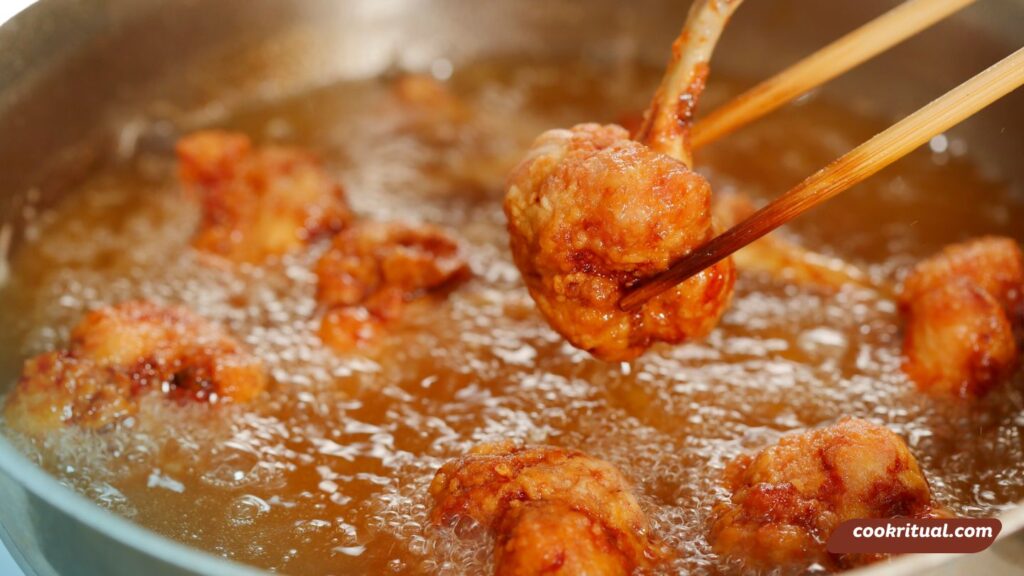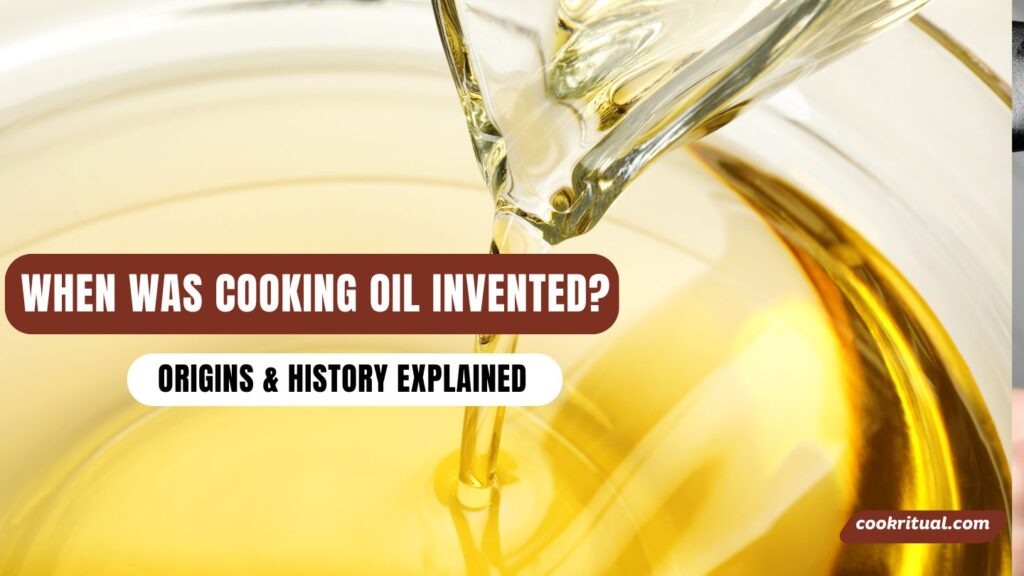Cooking oil has been around for thousands of years—first used by ancient civilizations as early as 3000 BCE. While we might take it for granted today, oil has played a central role in food preparation, preservation, and even medicine since the dawn of human history.
From drizzling olive oil over roasted vegetables to sautéing stir-fry in sesame oil, these liquid fats are more than just kitchen staples—they’re time-traveling ingredients with deep cultural roots. But when exactly was cooking oil invented? And how did people extract and use it long before electric presses and bottled brands?
In this article, we’ll uncover the fascinating story behind cooking oil—exploring its earliest uses, traditional extraction methods, and how it’s evolved into the wide variety of oils we rely on today. Whether you’re curious about food history, looking to make healthier choices, or just love a good kitchen origin story, you’re in the right place.
Contents
- 1 II. When Was Cooking Oil Invented? A Historical Perspective
- 2 III. Ancient Methods of Oil Extraction
- 3 IV. Evolution of Edible Oils: From Ancient to Modern Times
- 4 V. Cooking Oils Then vs Now: What’s Changed?
- 5 VI. Practical Guide: How Ancient Oil-Making Influences Modern DIY Oil Production
- 6 VII. Buying Guide: Choosing the Right Cooking Oil Today
- 7 VIII. Common FAQs About the History of Cooking Oil
- 8 X. Conclusion: From Ancient Traditions to Modern Kitchens
II. When Was Cooking Oil Invented? A Historical Perspective

Earliest Known Use of Cooking Oil
Cooking oil dates back over 5,000 years. Archaeologists have found evidence of olive oil production in ancient Mesopotamia, around 3000 BCE. These early societies used oil not only in cooking but also in rituals and medicine.
In Egypt, olive and sesame oils were stored in clay jars and used in baking and frying. Ancient China used soybeans and hemp to press oils as early as 2000 BCE. These oils weren’t just for flavor—they were also prized for their health benefits and ability to preserve food.
Timeline of Cooking Oil Development
Let’s look at how cooking oil spread across regions and time:
| Period/Region | Key Development | Primary Oils Used |
| 3000 BCE – Mesopotamia | First olive oil production | Olive oil |
| 2500 BCE – Egypt | Use in cooking and rituals | Sesame, castor, olive |
| 2000 BCE – China | Early pressing of soybeans | Soybean, hemp |
| 1500 BCE – India | Use of mustard seed oil | Mustard oil |
| 800 BCE – Greece & Rome | Mass use in cooking | Olive, sesame |
| Middle Ages | Animal fats used widely | Lard, butter |
| 19th Century | Rise of industrial oil presses | Cottonseed, canola |
Cultural Significance
Oil wasn’t just fuel for the body—it was sacred in many cultures. In ancient Greece, olive oil was used to anoint athletes and kings. In India, mustard and coconut oil featured in Ayurveda, the traditional healing system. These oils played a part in spiritual rituals, skin care, and preserving food—showing just how valuable they were in everyday life.
III. Ancient Methods of Oil Extraction
Traditional Oil Pressing Techniques
Before machines, people used manual tools to extract oil from seeds and fruits. The methods varied by region, but all relied on pressure, heat, or both.
- Mortar and Pestle – Common in early cultures to crush seeds.
- Stone Mills – Round stones rolled over seeds to release oil.
- Wooden Presses – Hand-cranked or weighted to extract oil slowly.
- Boiling – Some oils like coconut were extracted by boiling and skimming off the oil.
These methods were slow but effective, and they kept the oil natural and pure.
Sources of Oil in Early Civilizations
Different regions used what was locally available:
- Olive oil in the Mediterranean
- Sesame and mustard oil in the Middle East and India
- Soybean and hemp oil in China
- Coconut oil in Southeast Asia
- Animal fats like lard and tallow in Europe
Most early oils were unrefined, making them rich in nutrients and strong in flavor.
How Oil Was Stored and Preserved
Without refrigeration, ancient people had to be smart about oil storage. They used clay pots or sealed glass bottles to keep air and sunlight out. Some added herbs or spices, which helped delay spoilage and added flavor.
Even then, oils were used quickly or stored in cool, dark places—something we still recommend today for oils like extra virgin olive oil.
IV. Evolution of Edible Oils: From Ancient to Modern Times

Development of Vegetable Oils
Vegetable oils started expanding in use around the 1800s, when industrial oil presses became available. Farmers and producers began using seeds like cotton, sunflower, and canola on a large scale. With machines, more oil could be made faster, though sometimes at the cost of nutrition.
By the 20th century, refined oils became common, especially in the United States. These oils were clear, light-tasting, and shelf-stable, which fit busy lifestyles.
Industrialization and Modern Oil Processing
Modern oil production often uses heat and chemicals to extract and clean the oil. This makes it cheaper and more stable, but it may remove some natural nutrients.
Two main types of oil processing today are:
- Cold-Pressed – Oil is extracted without heat. Keeps flavor and nutrients.
- Refined – Uses high heat and solvents. Removes smell, taste, and some nutrients.
Each method has its pros and cons depending on how you cook and what your health goals are.
Changes in Consumption and Health Perception Over Time
For centuries, oil was seen as energy-rich and healing. But in the mid-20th century, fats were blamed for heart disease. This led to a shift toward low-fat diets and synthetic oils like margarine.
Today, we know more. Research from Harvard Health shows that healthy fats—like those from olive, avocado, and flaxseed oil—can actually support heart and brain health.
We’ve come full circle—valuing traditional, less processed oils again for their benefits.
V. Cooking Oils Then vs Now: What’s Changed?
Traditional Oils vs Modern Alternatives
Old-style oils like extra virgin olive oil, sesame, and coconut were made with care and used fresh. These oils were full of flavor and nutrients because they weren’t processed much. Today, many oils are refined with heat and chemicals to last longer and look clear.
Let’s compare the differences:
| Feature | Traditional Oils | Modern Oils |
| Processing | Cold-pressed, hand-extracted | Heat-processed, refined |
| Shelf Life | Shorter | Longer |
| Flavor | Strong and nutty | Mild or neutral |
| Nutrition | High in natural antioxidants | May lose nutrients |
| Examples | Olive, sesame, mustard | Canola, corn, vegetable blend |
Traditional oils are often richer in healthy fats. Modern oils focus on being neutral and cheap. Both have their place, but we should understand what we’re using and why.
Health Impacts and Nutritional Insights
In the past, oils were seen as good energy sources. Now, we think more about how oils affect the heart and body. According to the American Heart Association, oils rich in unsaturated fats—like olive, sunflower, or avocado—may help lower cholesterol.
But some refined oils (especially those high in omega-6 fatty acids) can cause problems when eaten too often. It’s all about balance. Using oils with care—just like people did in the past—can support a healthy diet.
Sustainability and Environmental Impact
Long ago, oil was made in small batches using local crops. Today, large-scale oil farming can harm the land. For example, palm oil farms often cause deforestation.
We can make better choices by picking oils that are sustainably sourced, organic, or from local farms. Ancient ways of making oil used less waste. Modern consumers can follow that same path with mindful buying.
VI. Practical Guide: How Ancient Oil-Making Influences Modern DIY Oil Production
Step-by-Step: Making Cooking Oil at Home Today
Want to try making your own oil? It’s easier than you think. The old ways—crushing seeds and pressing them—still work with simple tools.
Here’s a beginner-friendly process:
- Pick your seeds or nuts – Try sunflower seeds, flaxseeds, sesame, or walnuts.
- Clean and dry them – Moisture can spoil your oil.
- Grind the seeds – Use a food processor or hand-crank grinder.
- Press the paste – A manual oil press works well here.
- Strain the oil – Use cheesecloth or a fine strainer.
- Store in dark glass bottles – Keep them in a cool, dark place.
This method gives you fresh, flavorful oil without additives.
Tips on Choosing Natural and Authentic Oils
When buying oil, look for:
- Cold-pressed or extra virgin on the label
- Dark bottles to protect from light
- Single ingredient listings (no blends or fillers)
- Organic or non-GMO if possible
Avoid oils with long ingredient lists or unclear sources.
How to Store Homemade Oils Safely
Homemade oils don’t have preservatives. Store them like ancient cultures did:
- Use dark glass bottles
- Keep them in the fridge or a cool cupboard
- Finish within a few weeks
- Sniff before using—if it smells off, toss it
This keeps the oil fresh and safe to eat.
VII. Buying Guide: Choosing the Right Cooking Oil Today
Understanding Labels (Cold-Pressed, Virgin, Refined)
Oil labels can be confusing. Here’s what the terms mean:
- Cold-Pressed – Made without heat; keeps nutrients.
- Virgin or Extra Virgin – High quality, less processed, more flavor.
- Refined – Heated and filtered; longer shelf life but fewer nutrients.
Look for USDA organic or “non-GMO” if you’re avoiding synthetic additives.
Comparing Modern Cooking Oils
Use this table to pick the right oil for your needs:
| Oil Type | Best For | Smoke Point | Health Benefits |
| Olive Oil (Extra Virgin) | Salads, low-heat cooking | ~375°F | Heart-healthy fats |
| Avocado Oil | Grilling, frying | ~520°F | High in vitamin E |
| Coconut Oil | Baking, stir-fry | ~350°F | Stable for high heat |
| Canola Oil | Baking, sautéing | ~400°F | Low in saturated fat |
| Sunflower Oil | Frying | ~450°F | Rich in vitamin E |
Harvard T.H. Chan School of Public Health offers more detail on each oil’s health profile.
What to Use for Different Cooking Methods
- Raw dishes – Use extra virgin olive or flaxseed oil
- Baking – Canola or coconut oil
- Frying – Avocado or sunflower oil
- Grilling or roasting – Use oils with high smoke points like avocado
Using the right oil for each method helps keep both the food and nutrients intact.
VIII. Common FAQs About the History of Cooking Oil
Did ancient people really cook with oil?
Yes! Ancient Egyptians, Greeks, Chinese, and Indians all used oils in cooking. They pressed oils from olives, sesame seeds, mustard seeds, and soybeans. These oils were used for frying, baking, and even preserving food.
What was the first cooking oil ever used?
Olive oil is one of the earliest documented cooking oils. It was first used around 3000 BCE in ancient Mesopotamia, followed by sesame and mustard oils in India and the Middle East.
How did people store oil without refrigeration?
They used clay jars or sealed glass containers. Oils were kept in cool, dark places to protect them from light and heat—just like we recommend today for extra virgin olive oil.
Are old methods of making oil still used today?
Yes, especially in artisanal or small-scale farms. Many brands now offer “cold-pressed” or “stone-milled” oils that follow ancient practices, preserving nutrients and taste.
Is homemade oil safe to consume?
Yes, if made and stored properly. Use fresh seeds, press them cleanly, strain the oil well, and store it in sealed glass containers in the fridge or a dark pantry.
X. Conclusion: From Ancient Traditions to Modern Kitchens
Cooking oil has come a long way—from ancient hand-crushed seeds to today’s sleek bottles on supermarket shelves. But the heart of it hasn’t changed. Oil is still a symbol of nourishment, comfort, and connection in kitchens across the world.
By understanding its roots, we can make smarter choices about the oils we use today. Whether it’s pressing our own at home, picking the healthiest option at the store, or trying a new oil in our favorite recipe, we’re continuing a tradition thousands of years in the making.
Let’s keep honoring those simple, smart, and flavorful beginnings—one drop of oil at a time.


